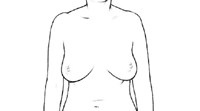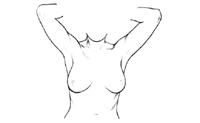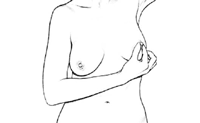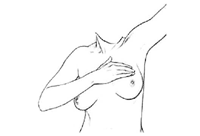Breast Self-Examination
What is a breast self-examination (BSE)?
Breast self-examination is a procedure performed by an individual to physically and visually examine herself for any changes in the breasts and underarm areas of the body. It has not been shown that BSE alone can accurately determine the presence of breast cancer. If you choose to do BSE, it should not be used in place of, but in addition to, clinical breast examination (performed by a health care provider every three years for women in their 20s and 30s, and every year for women ages 40 and older) and mammography.
When should BSE be done?
By doing BSE regularly, you get to know how your breasts normally feel and look so that you are able to detect any changes more easily.
Women can begin practicing breast self-examination at about age 20 and continue the practice throughout their lives - even during pregnancy and after menopause.
Breast self-examination (BSE) can be performed every month. Become familiar with how your breasts usually look and feel so that you may notice any change from what is normal for you.
-
If you still menstruate, the best time to do BSE is several days, or about a week, after your period ends. These are the days when your breasts are least likely to be tender or swollen.
-
If you no longer menstruate, pick a certain day - such as the first day of each month - to remind yourself to do BSE.
-
If you are taking hormones, talk with your physician about when to do BSE.
Changes to be aware of:
Check with your physician if you find any change in your breast(s) that causes you concern. Changes in your breasts may include:
-
Development of a lump
-
A discharge other than breast milk
-
Swelling of the breast
-
Skin irritation or dimpling
-
Nipple abnormalities (such as pain, redness, scaliness, turning inward)
How to do BSE:
1. Stand in front of a mirror that is large enough for you to see your breasts clearly. Check each breast for anything unusual. Check the skin for puckering, dimpling, or scaliness. Look for a discharge from the nipples.

2. Watching closely in the mirror, clasp your hands behind your head and press your hands forward.

3. Next, press your hands firmly on your hips and bend slightly toward the mirror as you pull your shoulders and elbows forward.

Do steps 2 and 3 to check for any change in the shape or contour of your breasts. As you do these steps, you should feel your chest muscles tighten.
4. Gently squeeze each nipple and look for a discharge.

5. The breasts are best examined while lying down because it spreads the breast tissue evenly over the chest. Lie flat on your back, with one arm over your head and a pillow or folded towel under the shoulder. This position flattens the breast and makes it easier to check.

Use the pads of the fingers of your other hand to check the breast and the surrounding area firmly, carefully, and thoroughly. Some women like to use lotion or powder to help their fingers glide easily over the skin. Feel for any unusual lump or mass under the skin. Feel the tissue by pressing your fingers in small, overlapping areas about the size of a dime. To be sure you cover the whole breast, take your time and follow a definite pattern: lines, circles, or wedges.

Some research suggests that many women do BSE more thoroughly when they use a pattern of up-and-down lines or strips. Other women feel more comfortable with another pattern. The important thing is to cover the whole breast and to pay special attention to the area between the breast and the underarm, including the underarm itself. Check the area above the breast, up to the collarbone, and all the way over to your shoulder.
-
Lines: Start in the underarm area and move your fingers downward little by little until they are below the breast. Then move your fingers slightly toward the middle and slowly move back up. Go up and down until you cover the whole area.
-
Circles: Beginning at the outer edge of your breast, move your fingers slowly around the whole breast in a circle. Move around the breast in smaller and smaller circles, gradually working toward the nipple. Don't forget to check the underarm and upper chest areas, too.
-
Wedges: Starting at the outer edge of the breast, move your fingers toward the nipple and back to the edge. Check your whole breast, covering one small wedge-shaped section at a time. Be sure to check the underarm area and the upper chest.
The American Cancer Society recommends using three different levels of pressure to examine your breasts:
-
Light pressure - to examine the tissue closest to the skin
-
Medium pressure - to feel a little deeper
-
Firm pressure - to feel deeper tissue closer to the chest wall
6. Some women repeat step 5 in the shower. Your fingers will glide easily over soapy skin, so you can concentrate on feeling for changes underneath.
What do you do if you find a lump?
One of the most frightening moments for a woman is if she sees or feels something different or unusual while performing breast self-examination. One of the most important reasons to perform regular breast self-examination is so that you know what is normal for your breasts. If you find a lump, it is important not to panic.
If you discover lumpiness in one breast or feel something "different" in the tissue, or you feel a definite lump, there may be valid reason for concern and it is important to contact your physician. Sometimes, the lumpiness may be due to menstrual changes; however, if you have nipple discharge or skin changes such as dimpling or puckering, your physician may want to see you right away.
It is natural to be frightened when discovering a lump, but do not let the prospect of cancer delay you from taking action. Remember that most breast lumps are benign (not cancer).